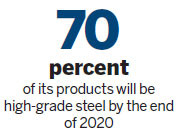Search This Supplers Products:steel pipeBossen steel tubeBossen steel plankBossen steel coilBossen scaffoldingBossen steel sheet
Capacity cuts reflect change in industry
sourceWebside
publisherLandy lu
time2016/08/19
- Capacity cuts reflect change in industry
Zhang Jiwen almost lost his job when a furnace where he worked for many years was demolished at Xuansteel, a subsidiary of Hesteel Group Co Ltd, in Hebei province.
But thanks to his determination to adapt, he secured the necessary training in new skills and became a quality inspector at the company's technology center.
Demolishing the Xuansteel furnace was the first step in its move to trim overcapacity. It was once the company's top producer, churning out 1,500 tons of iron a day. With its demolition, Hesteel cut annual iron capacity by 520,000 tons.
"Cutting overcapacity is the first important step to reform," says Hesteel Group Chairman Yu Yong, who adds that the restructuring will help enhance its competitive abilities.

In the first half of the year, high-grade steel products accounted for just over 50 percent of Hesteel's total output, according to its own data.
The group produced 5.36 million tons of high-end products during the same period, an increase of 121 percent on the same period last year.
On the flipside, output of crude steel and plain-carbon steel products was reduced by 11.33 percent and 9.16 percent respectively during the first four months.
By the end of 2020, the group says, 70 percent of its products will be high-grade steel.
While upgrading its steel products, the company says it is also fostering new driving forces by developing its nonsteel business. These include logistics, trade, equipment manufacturing, healthcare and social services.
By the end of 2020, the nonsteel business of Hesteel is expected to generate 3.5 billion yuan ($527 million; 471 million euros) of profit for the year, contributing about 35 percent of total earnings.
According to the Hebei Bureau of Statistics, iron and steel is no longer Hebei province's No 1 industry, with equipment manufacturing taking the top spot in the first half of this year. The bureau adds that value also increased by 134.86 billion yuan year-on-year in the same period.
